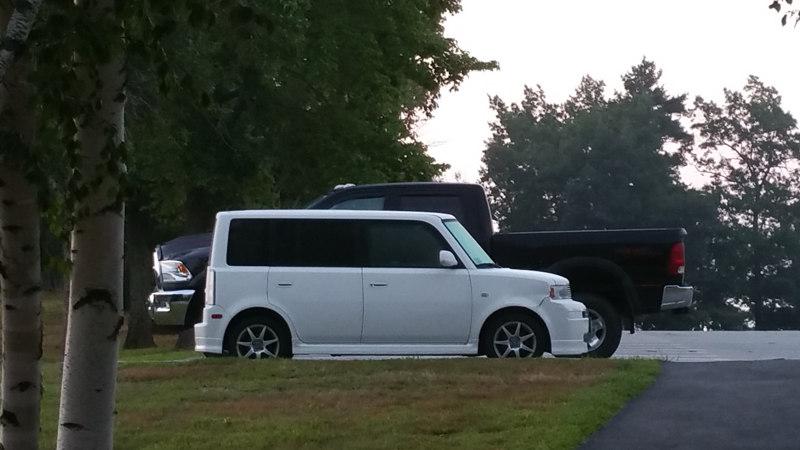-
Posts
9,217 -
Joined
-
Last visited
Content Type
Profiles
Forums
Events
Gallery
Everything posted by peteski
-

Steering wheel "Wrap"???
peteski replied to 426-Hemi's topic in General Automotive Talk (Trucks and Cars)
I can't visualize how a flat plastic coated wire tie could be wrapped around the rim of a 1:24 scale wheel and look like a leather cover. Not only it seems way too thick (and stiff), it will be also way too wide. Those things are usually about 1/4" wide. that would be scale 6.25" wide! Or is the model in question 1:8 scale? -

13" wheels in 1:24 scale. Help!
peteski replied to Chris1992's topic in General Automotive Talk (Trucks and Cars)
You are probably correct. -

The Jupiter 2
peteski replied to Lizz62's topic in WIP: All The Rest: Motorcycles, Aviation, Military, Sci-Fi, Figures
That is some outstanding work. Even with all the aftermarket items and lights, it must have taken many, many hours of fun modeling! Thanks for offering me the figures. I would love to build (and light) one of these up, but with all my planned, started, and in-progress projects I know that won't happen for a very long time. -

13" wheels in 1:24 scale. Help!
peteski replied to Chris1992's topic in General Automotive Talk (Trucks and Cars)
Frogeye Sprite?! Nice! It is so ugly, it's cute. I have a Gunze Sangyo model of that car I'll build one of this days. Last year I saw one of those in-person for the fist time in my life. It is so tiny that it coudl almost pass for a child's pedal car! Must be a fun car to drive. Here is a good example of how small my xB is. One morning I was leaving work and I saw my car against a silhouette of a Dodge Ram truck of one of my co-workers. The overall length of my car is just slightly larger then the truck's wheelbase! -

Steering wheel "Wrap"???
peteski replied to 426-Hemi's topic in General Automotive Talk (Trucks and Cars)
How about just scoring the spiral line around the rim using a hobby knife, then paint it the color of the wrap? That should be just about right for 1:24/25 scale. If your hand is not steady enough to make an even cut then cut a thin strip of plain (or maybeTamiya?) masking tape, wrap it around the rim, then follow the edge of the tape when scoring with the knife. Come to think of it, maybe the masking tape itself would make a good wrap? I'm assuming here that the steering wheel was wrapped with a long thin piece of leather (Not a donut-shaped wrap). -

1/16 Scale Army Vega Funny Car - Finished 10/14/2018
peteski replied to Mooneyzs's topic in WIP: Drag Racing Models
I agree 100% and I tried. But I find myself searching for the "meat" in between all the kudos and grattitude posts (which outnumber the "meat" of the thread by quite a bit. I gave up after few going through several hundreds of posts. I'm not trying to take anything away from the master-builder or the meticulous build quality - all the kudos are well-deserved of course, but if I could get a copy of this thread with just the build posts that would make an awesome tutorial (about the model and the 1:1 scale car). -

The Jupiter 2
peteski replied to Lizz62's topic in WIP: All The Rest: Motorcycles, Aviation, Military, Sci-Fi, Figures
Are those models kits or scratchbuilt? If those are kits, do they include the full interior and figures? What did you use for electronics to drive the LEDs? How are they powered (internal battery or external power)? -

The Jupiter 2
peteski replied to Lizz62's topic in WIP: All The Rest: Motorcycles, Aviation, Military, Sci-Fi, Figures
Well-done and great photos! -

13" wheels in 1:24 scale. Help!
peteski replied to Chris1992's topic in General Automotive Talk (Trucks and Cars)
That is one awesome looking Mini Cooper (and cute as hell too)! I drive a Scion xB (the 1st generation Toyota bB, aka. "the box"). It is a small car on American roads full of giant SUVs. Couple of years ago I was driving on a highway when I came upon a stock (unmodified) Mini Cooper like yours. It was so much smaller than my (already small) car. As I got closer I noticed a sticker on the rear window. It read "Yeah, it's got a HEMI". I never laughed so hard! BTW, there seems to be a shark's mouth on the blue vehicle reflected in your Mini - what is that? -

63 Ford Photo etch?
peteski replied to Rdkingjay's topic in General Automotive Talk (Trucks and Cars)
Maybe another photetched fret (for different model Ford) would have the script close enough to what you're looking for. If the script is small, maybe a fret for a 1:43 scale model? There is a seller on eBay selling hundreds of chrome stickers of car logos. Like the ones included with Tamiya kits. Maybe you'll find something appropriate there. http://stores.ebay.com/globaltoy/Automotive-/_i.html?_fsub=3028123016&_sid=917320676&_trksid=p4634.c0.m322 -

Forward opening hoods?
peteski replied to Jon Haigwood's topic in Model Building Questions and Answers
Same type of a hinge you would use for doors which swing out from the body (which is what most modelers use when they open the doors on their models). Then glue the stationary part of the hinge (a tube) under the top of the nose, forward of the hood opening. Not the best angle, but here is how I did it on my 1:43 Cobra model. -

Model rubber tire rot, has it happened to you.
peteski replied to ranma's topic in General Automotive Talk (Trucks and Cars)
Comparing multi-piece cardboard tires made from several hand-assembled pieces of cardboard to 1-piece molded vinyl tires is like comparing apples to oranges. I guess because vinyl (and rubber) are flexible (unlike polystyrene which is a hard plastic) it can be molded with complex tread pattern while using a fairly simple mold. At least that is what I gather reading this thread. But to get the same level of detail in a hard plastic tire would take a complex multi-part mold (which is much more expensive to make). There also are many tires out there molded out of resin with very high level of detail but those are molded in rubber molds which makes the process workable. Unfortunately this molding process doesn't work for high-volume production of plastic model kits. -

Model rubber tire rot, has it happened to you.
peteski replied to ranma's topic in General Automotive Talk (Trucks and Cars)
That stuff will probably come of using some Naphtha (lighter fluid) or 99% Isopropyl Alcohol. Just try not to get any of those solvents in contact with paint for more than few seconds. -
It won't work very well. It is a solvent-based rubber material which will shrink as it dries (hardens). Unless the mold is very thin, the drying process will be very long and the shrinkage will be very noticeable. RTV rubber mold material hardens by a chemical reaction (not solvent evaporation), so there is no appreciable shrinkage and it will set in thick layers.
-

Auto Quiz #325 - FINISHED
peteski replied to carsntrucks4you's topic in Real or Model? / Auto ID Quiz
Exactly. I didn't feel like looking up the year and model but then the answer almost fell in my lap when I opened up the latest issue of Collectible Automobile magazine. There was an article about the AMC Ambassador (larger brother of the Matador). That gave me the approximate year. Amazing how similar the Ambassador and Matador look in the photos. -
I have that kit with no instructions and it looks like parts are missing. Having a copy of the instructions would be helpful. I did some Google searches but couldn't locate a scan of the instructions. I'm hoping someone here knows where I could find a copy or a scan of those instructions. I know it is not a car kit, but it does have 4 wheels and has a 2-mulepower engine.
-

C'mon USPS!
peteski replied to StevenGuthmiller's topic in General Automotive Talk (Trucks and Cars)
UPS stores (at least the ones around my area) are not part of UPS - they are their own entities. So whatever they did (packing-wise) it is their doing (not UPS). But since UPS now charges per volume (not weight) of a package, maybe the UPS store is in collusion with the UPS mothership to maximize their profit? -

Lamborghini Countach Gold Wheel Paint
peteski replied to Mike Chernecki's topic in Model Building Questions and Answers
That is an unusual (satin metallic) color. I wonder if adding bit of silver paint to the brass/gold paint would give the right look? That is if you airbrushing them of course. Do a spoon test before painting the wheels. -
If you really want an impressive model you can construct hinges which will work like the ones on the real car (where the front edge of the door swings to the inside of the fender, not like a typical die-cast or Hot-Wheels model where the door swings out from the fender. Just observe how the hinge of your 1:1 car is built and make a miniature version. You might have to thin the fender at the door opening to allow the door to swing in.
-
From my experience heat accelerates both, drying and hardening (oxidizing) of the enamels. That is why I use the dehydrator to speed things up.
-
Yes, ink-jet ink in consumer-grade printers is water-soluble. Water washes it away. Alps ink or laser printer toner do not have that problem - they are water-resistant.
-
The P1800 is a really good looking car. Then there was the other "Saint" who drove a white Jag.

